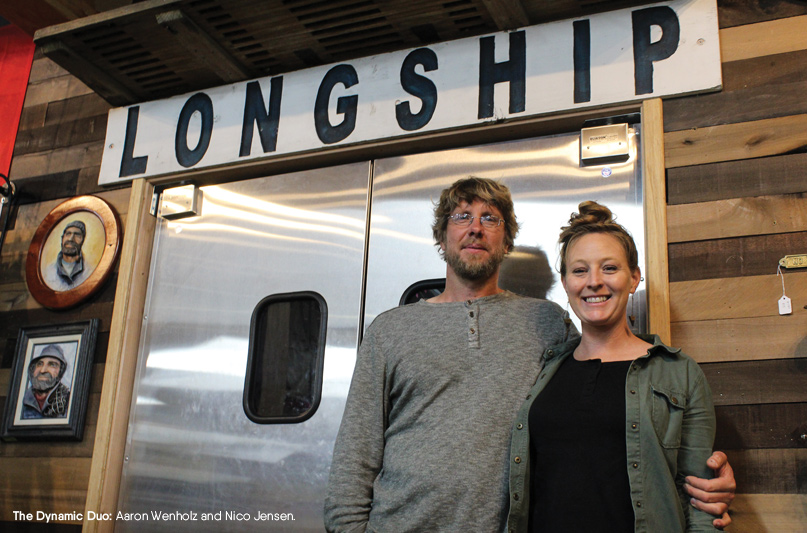
 There is no denying magic exists in marine consignment stores. Often this power is felt as a surprise within an unassuming old building as at home on a small town’s sea salty waterfront as a barnacle on the tide. You open an ancient, creaking door to an old bell’s trill and behold the magnificent piles of treasure chest loot a century in the making.
There is no denying magic exists in marine consignment stores. Often this power is felt as a surprise within an unassuming old building as at home on a small town’s sea salty waterfront as a barnacle on the tide. You open an ancient, creaking door to an old bell’s trill and behold the magnificent piles of treasure chest loot a century in the making.
A porthole, its origin a mystery and brass luster seasoned, sits before you with a $70 sales tag. The rack of used anchors catches your eye. Sure, more than one has a bent fluke, but one looks just fine with a price that gives you a singular kind of thrill; the rush of a bargain only your eye could’ve possibly identified.
You become the ace trophy hunter on safari; a perfectly serviceable tiller for $20, a Chapman’s Guide to Piloting and Seamanship only two editions behind the times, and two old but clean five-gallon jerry jugs for $10 apiece that you realize you just need for the dinghy.
This, my friends, is paradise. These mom-and-pop establishments are the beloved independent neighborhood bookstores of the sea; the diner down Main Street that defines a whole town. And they are an increasingly rare breed. With the recent closing of Latitude Marine in La Conner, Washington, and the general retreat of maritime-related businesses from the Seattle area ranging from the end of Jensen Boatyard on Lake Union to the Boats Afloat Show’s migration to Everett, more than a few Cascadian maritime professionals I interact with believe that we are seeing the End Times.
Puget Sound, and perhaps the United States as a country or even Earth as a planet, belongs to multinational corporations. It belongs to office jockeys. It belongs to the M.B.A.-staffed, LinkedIn-influencing, tech-managing conglomerates who see boats as a status boosting Instagram photo opp. Who see waterfront and think “That could all be condos.”
But one couple, a former nurse and sailboat rigger living on one of their two wooden boats in Poulsbo, is making a glorious stand. Defying the long odds, Aaron Wenholz and Nico Jensen have re-opened Longship Marine in an all-or-nothing gamble to save the business
and help carry Poulsbo’s waterfront into the future.
I stand outside Longship Marine on an unassuming Tuesday in August, one of a handful of boaters pacing hungrily outside the doors before business hours. The historic multistory building stands proudly over the Poulsbo waterfront, a cathedral to boating a stone’s throw away from the Sons of Norway lodge.
Once I’m inside, Wenholz and Jensen are kind enough to tell me their story before the crowd picks up. Wenholz, who ran Longship at its former location, paints a nerve-wracking scene. The first wave of morning customers spreads out throughout the store as he talks.
“Our previous building sold last March, and we got a 30-day notice to vacate,” Wenholz begins. The development was a potential killer blow to the store.
“We were really considering closing the store when we couldn’t find anywhere to move to,” adds Jensen. “Aaron had a couple of great job offers at the time to go into other areas of the marine industry that would pay better than working for yourself. But he really wanted to continue with it.”
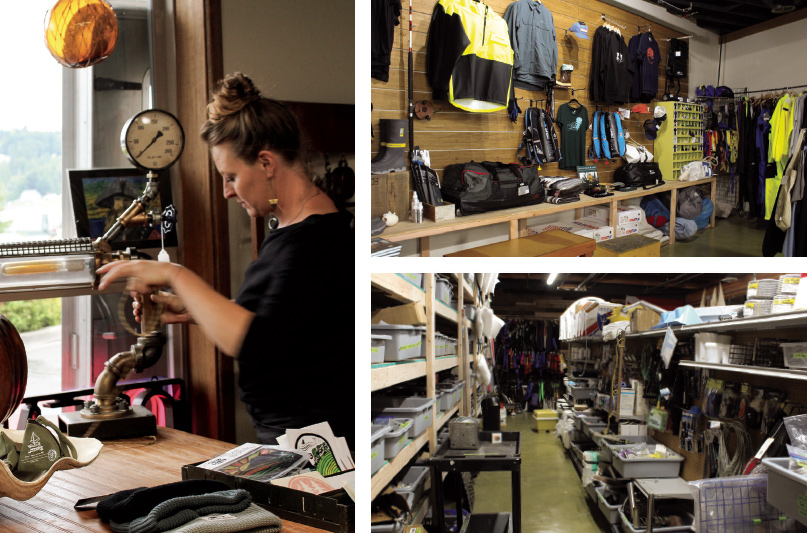
The pair looked far and wide for a possible new location, their choice to continue with the business hanging in the balance. Ultimately, the dream opportunity was a few doors down. “Turns out the owners of our old building also own this current building,” says Wenholz.
“It’s been vacant for years and years, and we pushed them to sell it to us. I think part of it was that they felt bad about the whole situation. Of course, it’s business, but it was very hard on us.”
While the business currently utilizes the bottom floor for the store, the upstairs contains a large open space known as the Old Grieg Hall Performance and Event Center. After a thorough renovation, the upstairs would be a perfect venue, boating education classroom, and space for marine tenants like a sailmaker. But as the couple’s eyes lit up with possibilities, the weight of what needed to be done hit the floor.
“We went from ‘oh, we get to go cruising for a month while the owners do the upgrades,’ to ‘oh, now we have to do all these repairs ourselves on the building and come up with a chunk of the money because we are the owners,’” recalls Jensen. “When we went to move, we were overwhelmed. We needed to stay open as much as we could make ends meet, so we moved the whole store in eight days.”
“We move out March 22 and took possession April 15,” said Wenholz. He shakes his head with a rueful smirk. “We didn’t have any money.” A few personal loans in combination with throwing every dollar they had at the project was just enough. They were able to give the building needed upgrades per city requirements.
“We did most of the work ourselves except for the technical stuff like fire suppression,” says Wenholz. He was a general contractor for 12 years before his sailboat rigging career. “I found it pretty enjoyable except for the small amounts of money coming in and lots going out,” said Wenholz of the work on the new location. “I’m good with my hands and I’m good with people.”
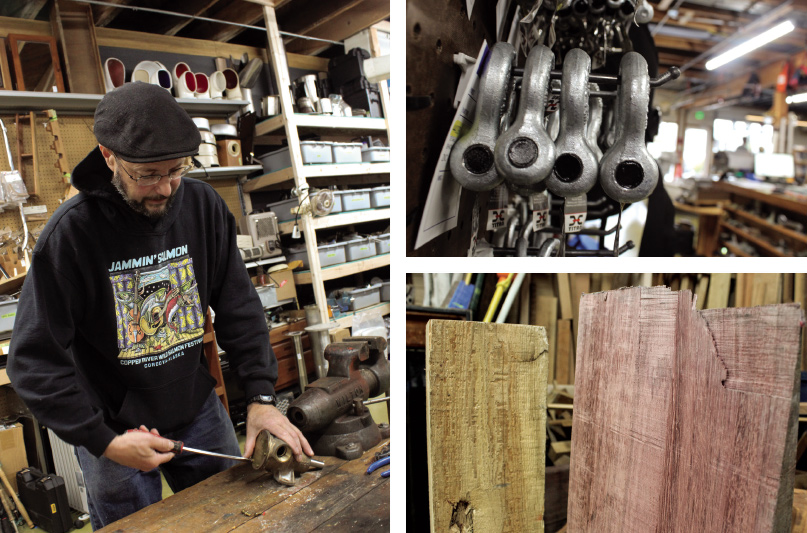
To the couple’s surprise, they would not charge into the unknown alone. Riding to their aid was The People, summoned through the mysterious power of dock talk. It is common knowledge that word travels farther over water.
“People just started coming from the community to help us move,” says Jensen. “We didn’t ask anybody to sign up or tell them when to show up, they just kept coming. It was perfectly orchestrated with trucks and trailers. It wasn’t fun or easy work either; there were very heavy brass and bronze items.”
With the blessing of The People, Longship as it is now started to take form. “People were coming by during the whole setup, chomping at the bit and saying things like, ‘Why is it taking so long? Can I help?’” recalls Jensen. “When we opened the doors, our deepest fear was that it was going to be crickets. But it’s been busier than ever before.”
Wenholz glances at the store filling up with a typically strong weekday showing. “We pushed through it and we’re open again. It’s fantastic,” he says with the hint of a grin.
When talking to the couple about their callings to the Pacific Northwest boating world, the feeling that the two were destined to open this new chapter of Longship Marine deepens.
Nico Jensen went to Bastyr University where she studied botanical medicine and afterwards worked in nursing and emergency medicine. She moved onto the Kitsap Peninsula for a job.
“Aaron had an ad posted on Craigslist for a boat he had for sale,” says Jensen. “I went to take a look at it. I was interested in living aboard and buying my first boat, but that one was too rough. But we stayed in touch after that.” She started a nautical antiques store in the Georgetown Trailer Park Mall called Rio’s Lode Star. “I sold more of the stuff Aaron had trouble moving around here that people from Seattle seemed to eat up.”
Aaron Wenholz’s background includes his nearly four-year role as the travelling rigger for Northwest Rigging. “I would go past Poulsbo quite a bit,” he remembers. “There was this new consignment store [Longship Marine] and I was spending quite a lot of time there. The lady who owned it kind of latched onto me.”
Eventually, the previous owner offered to sell him Longship Marine. After a soul-searching boat cruise to Alaska and back during the summer of 2012, he agreed. He officially took over Longship on November 1, 2012. Eventually, Wenholz managed to poach Jensen from Rio’s Lode Star, he with four and a half years solo running Longship and she with three years at her own business.
The two are the spitting image of a Pacific Northwest liveaboard couple, each individually called to life on the Salish Sea before even knowing each other.
“I had my own Matthews 40-foot wood boat for three and a half years. Then Aaron and I went to cohabitate, and we purchased a 1930 tugboat together,” Jensen says. It ended up being completely rotten inside. “We hauled it out in Port Townsend to do the bottom and realized what rough shape it was. It was a liability that we couldn’t even give away at that point. I think there were plenty of people in the yard looking at us sideways thinking ‘Oh these guys are going to skip. They’re going to leave this boat and run.’”

“I’m a boat nut,” adds Wenholz. “We’ve got two boats, one is that 1930 tug that Nico and I bought together to live on. It was one of those learning experiences. We pretty much rebuilt the entire boat.”
“We were overwhelmed for a couple of days, but then met a shipwright who took us under his wing—Bob Cunningham,” says Jensen. “He said the only thing holding the boat together is habit.” The two worked for three and a half months in the winter, replacing planks and sistering ribs. Only one more above-water plank remains to be replaced before the tug is ready for 25 or more years of active boating life.
“We were really fortunate to have Bob Cunningham help us,” Jensen grows reflective. “He died about a year and a half ago. We got to see the last boat he was working on and get the last bit of mentorship out of him.”
Besides the tug that they’re planning to sell soon, they’ve been living off the hook during the summer months on their larger wooden boat. Subleasing their end-tie slip saves them a few needed bucks. The two are virtually inseparable from Poulsbo.
“I call Poulsbo home and I love it,” says Wenholz. “It’s kind of a vortex that sucks you in and a year can go by and you haven’t even left. It’s like a lake out there, very easy to anchor. It’s tucked away with good, real people. I’ve enjoyed it a lot; feel sort of stuck but in a good way. It [Poulsbo] keeps me grounded.”
We’re politely interrupted by a customer, a friendly boater wearing a plaid shirt. Wenholz helps the man at the do-it-yourself table, a marine supply store feature that’s increasingly rare.
“Our do-it-yourself table gets covered pretty quickly, but we try to have an open table where people can create things like their own battery cables,” says Wenholz.
“There’s a guy over there right now rebuilding his water pump; taking parts off getting ready for the new one. I use it all the time, but if someone needs it, they are welcome to use it.”
We start talking about the boating industry at-large. What are we losing when we get rid of do-it-yourself tables, boatyards, and other such resources?
“The problem with taking the do-it-yourself element out of boating is that there’s not enough tradespeople to support all of that,” says Wenholz. “So there’s not a lot of yards where you can do your own work.
There’s also not enough tradesmen to do all the work that’s necessary and the boats are just languishing, not because the customer isn’t capable, but because he keeps trying to get an electrician, but they flake out on him, they’re too busy if they’re good, or they don’t exist. We’re lacking in the boat trades for sure; we need more people in the marine industries.”
Another unique service that’s under the Longship Marine umbrella is the resurrection and sale of derelict boats. A sort of Humane Society for good old wooden boats, Wenholz and Jensen take on boat projects that nobody else wants to touch, then sell or donate them to a good forever home.
“It’s important to find a right owner for the boat,” adds Jensen. “Abandoned and deteriorating boats are costing the state a lot of money. Environmentally, it’s caustic. That’s why we’re passionate about this, but it’s got to be the right person to handle a wooden boat. Everyone underestimates that. We’re not going to sell a boat to someone who’s going to let the wooden boat go downhill.”
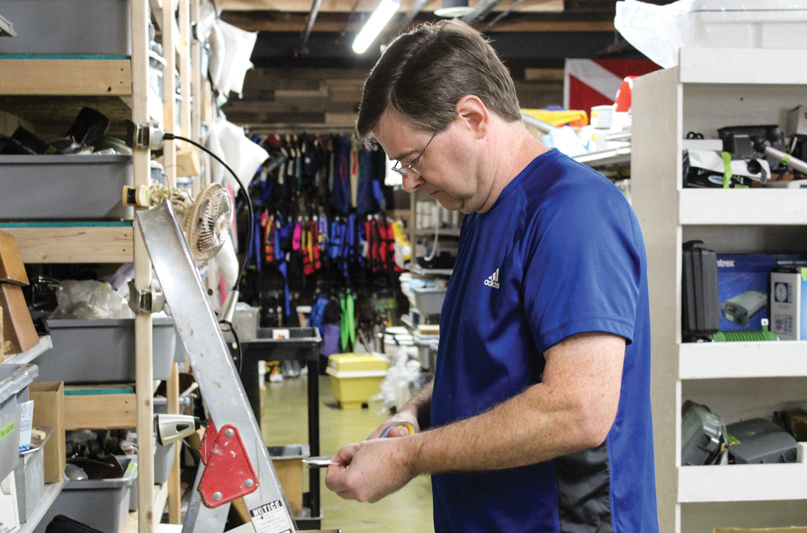
Wenholz agrees, “I feel like it’s a positive thing for the boating community. It’s not something I really planned on, but these people we sell boats to are now customers here.”
He chuckles, “It wasn’t my secret goal to create a bunch of customers, but it’s fun for me, good for the environment, and good for boats. We don’t need all these new plastic boats out there. There are some good old boats out there that are much better in my opinion.”
Longship Marine may have defied the odds to be reborn, but where many would be tempted to rest on their laurels, Wenholz and Jensen are still hungry for what can be.
“We are interested in expanding into boating education and instruction,” says Wenholz. “We bought this building that has that large upstairs, and we’re going to create that into an event space.”
Jensen gives me a walking tour of the upstairs. While empty and cavernous now, I begin to see the space through the Wenholz-Jensen lens. “We want to be more of a marine hub where people can get a bunch of services done,” explains Jensen. “People can get swaging done, receive on-boat consultations, and more. We want to make custom lazy jacks for boats and some other minor mechanical things.”
She goes on to explain how boating education is a key piece of Longship’s future. “There are so many awesome teachers out there. We think we know them all and then we go to a diesel maintenance class and we say ‘Oh my gosh! You’re brilliant!’ There’s 14 marinas in Kitsap Country, so there’s plenty of boaters to come to a captain or U.S. Coast Guard classes.” We return downstairs.
“Kitsap Peninsula doesn’t have much, just a West Marine and a little chandlery on Bainbridge,” says Wenholz. “But there’s a lot of boats out here and it’s a boating community. Poulsbo is all about boats. It was created on fishing and the marine industries. It’d be a shame to see that heritage go the other way.”
On my way out, I chat with Michael Snoozy, the outside salesman for Fisheries Supply who has worked with Longship Marine for many years. Thanks to the partnership with Fisheries and other marine suppliers, Longship Marine offers products both new and old.
Fisheries used to deliver inventory two days a week, but now they’re up to five. The partnership with Fisheries Supply is critical, allowing Longship to compete with Amazon’s next-day shipping while still maintaining the in-person customer connection.
I ask Snoozy about what Longship’s reopening means to him. His eyes light up. “If I can help them grow, I’m definitely going to help them bring in new products. The steady flow of people here is amazing. I don’t know how they control it all. It’s incredible.”
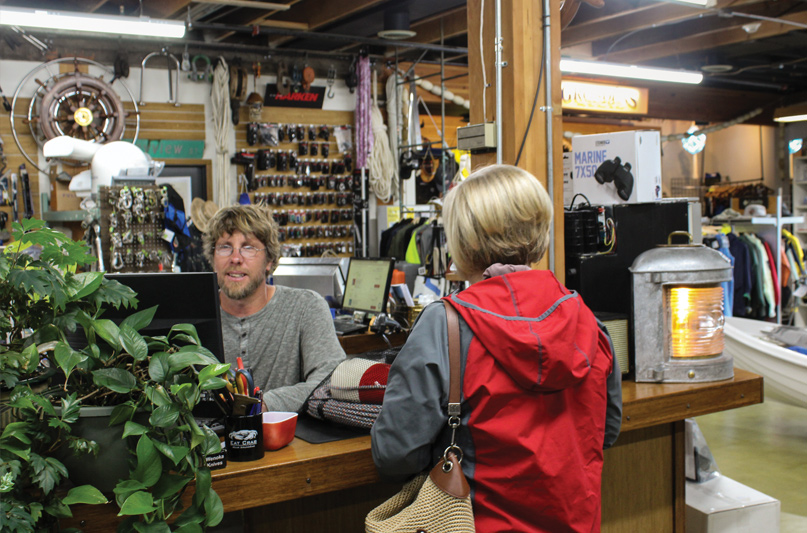
I look about the store. A customer haggles his used boat wares to Wenholz. Jensen organizes the shelves of boating-related books while answering questions from an older couple. “They’re good people,” Snoozy nods, turning his attention back to the inventory.
As an aspiring sea salt still getting the green out of his horns, the marine consignment and supply store magic of Longship Marine holds a familiar warmth for me.
It’s the warmth of returning to a home after a long absence combined with the joy of discovery, I’m at once both a weathered explorer and child proud with a shiny rock he found in the creek. I feel united with a culture I didn’t realize I missed, these champions of self-improvement, community-mindedness, nautical heritage, and resurrection. Weighty themes for a marine consignment store.
I urge every boater to visit the all-new Longship Marine in Poulsbo. Its very survival and continued growth will depend on our dollars, representing not just the hope of a hardworking couple but of an entire cultural identity.
Unless we take a stand for the do-it-yourself tables, the in-person consultations, the resurrection of good old boats, and the reuse of boat products, it will all go away. What we’ll have remaining are Amazon.com and the Walmarts of the sea. Good old boats will rot at their moorings, and gear, once used to appreciate the ocean, will be garbage polluting it.
The End Times.